Want to catch up with other articles from this series?
- The straight dope on cholesterol – Part I
- The straight dope on cholesterol – Part II
- The straight dope on cholesterol – Part III
- The straight dope on cholesterol – Part IV
- The straight dope on cholesterol – Part V
- The straight dope on cholesterol – Part VI
- The straight dope on cholesterol – Part VII
- The straight dope on cholesterol – Part VIII
- The straight dope on cholesterol – Part IX
Previously, across 8 parts of this series we’ve laid the groundwork to ask perhaps the most important question of all:
What should you eat to have the greatest chance of delaying the arrival of cardiovascular disease?
Before we get there, since this series has been longer and more detailed than any of us may have wanted, it is probably worth reviewing the summary points from the previous posts in this series (or you can just skip this and jump to the meat of this post).
What we’ve learned so far
- Cholesterol is “just” another fancy organic molecule in our body but with an interesting distinction: we eat it, we make it, we store it, and we excrete it – all in different amounts.
- The pool of cholesterol in our body is essential for life. No cholesterol = no life.
- Cholesterol exists in 2 forms – unesterified or “free” (UC) and esterified (CE) – and the form determines if we can absorb it or not, or store it or not (among other things).
- Much of the cholesterol we eat is in the form of CE. It is not absorbed and is excreted by our gut (i.e., leaves our body in stool). The reason this occurs is that CE not only has to be de-esterified, but it competes for absorption with the vastly larger amounts of UC supplied by the biliary route.
- Re-absorption of the cholesterol we synthesize in our body (i.e., endogenous produced cholesterol) is the dominant source of the cholesterol in our body. That is, most of the cholesterol in our body was made by our body.
- The process of regulating cholesterol is very complex and multifaceted with multiple layers of control. I’ve only touched on the absorption side, but the synthesis side is also complex and highly regulated. You will discover that synthesis and absorption are very interrelated.
- Eating cholesterol has very little impact on the cholesterol levels in your body. This is a fact, not my opinion. Anyone who tells you different is, at best, ignorant of this topic. At worst, they are a deliberate charlatan. Years ago the Canadian Guidelines removed the limitation of dietary cholesterol. The rest of the world, especially the United States, needs to catch up. To see an important reference on this topic, please look here.
- Cholesterol and triglycerides are not soluble in plasma (i.e., they can’t dissolve in water) and are therefore said to be hydrophobic.
- To be carried anywhere in our body, say from your liver to your coronary artery, they need to be carried by a special protein-wrapped transport vessel called a lipoprotein.
- As these “ships” called lipoproteins leave the liver they undergo a process of maturation where they shed much of their triglyceride “cargo” in the form of free fatty acid, and doing so makes them smaller and richer in cholesterol.
- Special proteins, apoproteins, play an important role in moving lipoproteins around the body and facilitating their interactions with other cells. The most important of these are the apoB class, residing on VLDL, IDL, and LDL particles, and the apoA-I class, residing for the most part on the HDL particles.
- Cholesterol transport in plasma occurs in both directions, from the liver and small intestine towards the periphery and back to the liver and small intestine (the “gut”).
- The major function of the apoB-containing particles is to traffic energy (triglycerides) to muscles and phospholipids to all cells. Their cholesterol is trafficked back to the liver. The apoA-I containing particles traffic cholesterol to steroidogenic tissues, adipocytes (a storage organ for cholesterol ester) and ultimately back to the liver, gut, or steroidogenic tissue.
- All lipoproteins are part of the human lipid transportation system and work harmoniously together to efficiently traffic lipids. As you are probably starting to appreciate, the trafficking pattern is highly complex and the lipoproteins constantly exchange their core and surface lipids.
- The measurement of cholesterol has undergone a dramatic evolution over the past 70 years with technology at the heart of the advance.
- Currently, most people in the United States (and the world for that matter) undergo a “standard” lipid panel, which only directly measures TC, TG, and HDL-C. LDL-C is measured or most often estimated.
- More advanced cholesterol measuring tests do exist to directly measure LDL-C (though none are standardized), along with the cholesterol content of other lipoproteins (e.g., VLDL, IDL) or lipoprotein subparticles.
- The most frequently used and guideline-recommended test that can count the number of LDL particles is either apolipoprotein B or LDL-P NMR, which is part of the NMR LipoProfile. NMR can also measure the size of LDL and other lipoprotein particles, which is valuable for predicting insulin resistance in drug naïve patients, before changes are noted in glucose or insulin levels.
- The progression from a completely normal artery to a “clogged” or atherosclerotic one follows a very clear path: an apoB containing particle gets past the endothelial layer into the subendothelial space, the particle and its cholesterol content is retained, immune cells arrive, an inflammatory response ensues “fixing” the apoB containing particles in place AND making more space for more of them.
- While inflammation plays a key role in this process, it’s the penetration of the endothelium and retention within the endothelium that drive the process.
- The most common apoB containing lipoprotein in this process is certainly the LDL particle. However, Lp(a) and apoB containing lipoproteins play a role also, especially in the insulin resistant person.
- If you want to stop atherosclerosis, you must lower the LDL particle number. Period.
- At first glance it would seem that patients with smaller LDL particles are at greater risk for atherosclerosis than patients with large LDL particles, all things equal.
- “A particle is a particle is a particle.” If you don’t know the number, you don’t know the risk.
- With respect to laboratory medicine, two markers that have a high correlation with a given outcome are concordant – they equally predict the same outcome. However, when the two tests do not correlate with each other they are said to be discordant.
- LDL-P (or apoB) is the best predictor of adverse cardiac events, which has been documented repeatedly in every major cardiovascular risk study.
- LDL-C is only a good predictor of adverse cardiac events when it is concordant with LDL-P; otherwise it is a poor predictor of risk.
- There is no way of determining which individual patient may have discordant LDL-C and LDL-P without measuring both markers.
- Discordance between LDL-C and LDL-P is even greater in populations with metabolic syndrome, including patients with diabetes. Given the ubiquity of these conditions in the U.S. population, and the special risk such patients carry for cardiovascular disease, it is difficult to justify use of LDL-C, HDL-C, and TG alone for risk stratification in all but the most select patients.
- To address this question, however, one must look at changes in cardiovascular events or direct markers of atherosclerosis (e.g., IMT) while holding LDL-P constant and then again holding LDL size constant. Only when you do this can you see that the relationship between size and event vanishes. The only thing that matters is the number of LDL particles – large, small, or mixed.
- HDL-C and HDL-P are not measuring the same thing, just as LDL-C and LDL-P are not.
- Secondary to the total HDL-P, all things equal it seems smaller HDL particles are more protective than large ones.
- As HDL-C levels rise, most often it is driven by a disproportionate rise in HDL size, not HDL-P.
- In the trials which were designed to prove that a drug that raised HDL-C would provide a reduction in cardiovascular events, no benefit occurred: estrogen studies (HERS, WHI), fibrate studies (FIELD, ACCORD), niacin studies, and CETP inhibition studies (dalcetrapib and torcetrapib). But, this says nothing of what happens when you raise HDL-P.
- Don’t believe the hype: HDL is important, and more HDL particles are better than few. But, raising HDL-C with a drug isn’t going to fix the problem. Making this even more complex is that HDL functionality is likely as important, or even more important, than HDL-P, but no such tests exist to “measure” this.
Did you say “delay?”
That’s right. The question posed above did not ask how one could “prevent” or eliminate the risk cardiovascular disease, it asked how one could “delay” it. There is a difference. To appreciate this distinction, it’s worth reading this recent publication by Allan Sniderman and colleagues. Allan sent me a copy of this paper ahead of publication a few months ago in response to a question I had posed to him over lunch one day. I asked,
“Allan, who has a greater 5-year risk for cardiovascular disease, a 25 year-old with a LDL-P/apoB in the 99th percentile or a 75-year-old with a LDL-P/apoB in the 5th percentile?”
The paper Allan wrote is noteworthy for at least 2 reasons:
- It’s an excellent reminder that age is a paramount risk factor for cardiovascular disease.
- It provides a much better (causal) model for atherosclerosis than the typical age-driven models, and explains why age is an important risk factor.
What do I mean by this? Most risk calculators (e.g., Framingham) take their inputs (e.g., age, gender, LDL-C, HDL-C, smoking, diabetes, blood pressure) and calculate a 10-year risk score. If you’ve ever played with these models you’ll quickly see that age drives risk more than any other input. But why? Is there something inherently “risky” about being older?
Sniderman and many others would argue (and I agree) that the reason age is a strong predictor of risk has to do with exposure to apoB particles — LDL, Lp(a), and apoB-carrying remnants. Maybe it’s because I’m a math geek, but such models just seem intuitive to me because I think of most things in life in terms of calculus, especially integrals, the “area under a curve.”
[I once tried to explain to a girlfriend who thought I wasn’t spending enough time with her that my interest in her should be thought of in terms of the area under the curve, rather than any single point in time. That is, think in terms of the integral function, not the point-in-time function. Needless to say, she broke up with me on the spot (in the middle of a parking lot!), despite me drawing a very cool picture illustrating the difference, which I’ve re-created, below.]
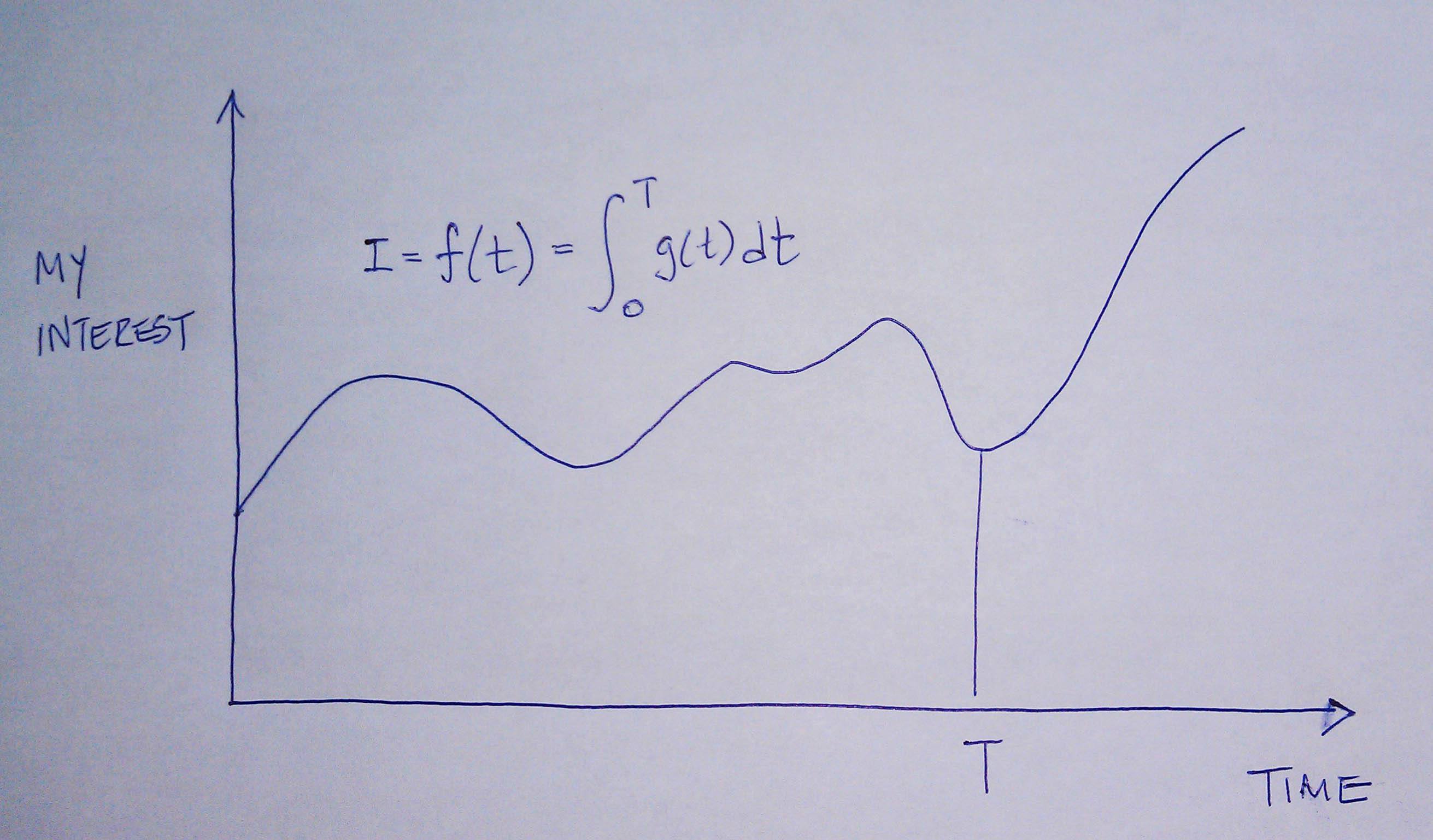
The reason age is such a big driver of risk is that the longer your artery walls are exposed to the insult of apoB particles, the more likely they are to be damaged, for all the reasons we covered in Part IV of this series. [This paper also reviews the clinical situation of PCSK9 mutations which builds a very compelling case for the causal model of apoB particles in the development of atherosclerosis].
What does eating have to do with cardiovascular risk?
So now that everyone is on the edge of their seat in anticipation of this punch-line, let me provide two important caveats.
First, there are no long-term studies – either in primary or secondary prevention – examining the exact question we all want to know the answer to with respect to the role of dietary intervention on cardiovascular disease. There are short-term studies, some of which I will highlight, which look at proxies for cardiovascular disease, but all of the long-term studies (looking at secondary prevention), are either drug studies or multiple intervention studies (e.g., cholesterol-lowering drug(s) + blood pressure reducing drug(s) + dietary intervention + exercise + …).
In other words, the “dream” study has not been done and won’t be done for a long time. The “dream” study would follow 2 randomized groups for many years and only make one change between the groups. Group 1 would consume a standard American diet and group 2 would consume a very-low carbohydrate diet. Furthermore, compliance within each group would be excellent (many ways to ensure this, but none of them are inexpensive – part of why this has not been done) and the study would be powered to detect “hard outcomes” (e.g., death), instead of just “soft outcomes” (e.g., changes in apoB, LDL-C, LDL-P, TG).
Second, everything we have learned to date on the risk relationship between cardiovascular disease and risk markers is predicated on the assumption that a risk maker of level X in a person on diet A is the same as it would be for a person on diet B.
Since virtually all of the thousands of subjects who have made up the dozens of studies that form the basis for our understanding on this topic were consuming some variant of the “standard American diet” (i.e., high-carb), it is quite possible that what we know about risk stratification is that this population is not entirely fit for extrapolation to a population on a radically different diet (e.g., a very-low carbohydrate diet or a ketogenic diet). Many of you have asked about this, and my comments have always been the same. It is entirely plausible that an elevated level of LDL-P or apoB in someone consuming a high-carb diet portends a greater risk than someone on a ketogenic or low-carb diet. There are many reasons why this might be the case, and there are many folks who have made compelling arguments for this hypothesis.
But we can’t forget the words of Thomas Henry Huxley, who said, “The great tragedy of science is the slaying of a beautiful hypothesis by an ugly fact.” Science is full of beautiful hypothesis slayed by ugly facts. Only time will tell if this hypothesis ends up in that same graveyard, or changes the way we think about lipoproteins and atherosclerosis.
The role of sugar in cardiovascular disease
Let’s start with what we know, then fill in the connections, with the goal of creating an eating strategy for those most interested in delaying the onset of cardiovascular disease.
There are several short-term studies that have carefully examined the impact of sugar, specifically, on cardiovascular risk markers. Let’s examine one of them closely. In 2011 Peter Havel and colleagues published a study titled Consumption of fructose and HFCS increases postprandial triglycerides, LDL-C, and apoB in young men and women. If you don’t have access to this journal, you can read the study here in pre-publication form. This was a randomized trial with 3 parallel arms (no cross-over). The 3 groups consumed an isocaloric diet (to individual baseline characteristics) consisting of 55% carbohydrate, 15% protein, and 30% fat. The difference between the 3 groups was in the form of their carbohydrates.
Group 1: received 25% of their total energy in the form of glucose
Group 2: received 25% of their total energy in the form of fructose
Group 3: received 25% of their total energy in the form of high fructose corn syrup (55% fructose, 45% glucose)
The intervention was relatively short, consisting of both an inpatient and outpatient period, and is described in the methodology section.
Keep in mind, 25% of total energy in the form of sugar is not as extreme as you might think. For a person consuming 2,400 kcal/day this amounts to about 120 pounds/year of sugar, which is slightly below the average consumption of annual sugar in the United States. In that sense, the subjects in Group 3 can be viewed as the “control” for the U.S. population, and Group 1 can be viewed as an intervention group for what happens when you do nothing more in your diet than remove sugar, which was the first dietary intervention I made in 2009.
Despite the short duration of this study and the relatively small number of subjects (16 per group), the differences brought on by the interventions were significant. The figure below shows the changes in serum triglycerides via 3 different ways of measuring them. Figure A shows the difference in 24-hour total levels (i.e., the area under the curve for serial measurements – hey, there’s our integral function again!). Figure B shows late evening (post-prandial) differences. Figure C shows the overall change in fasting triglyceride level from baseline (where sugar intake was limited for 2 weeks and carbohydrate consumption consisted only of complex carbohydrates).
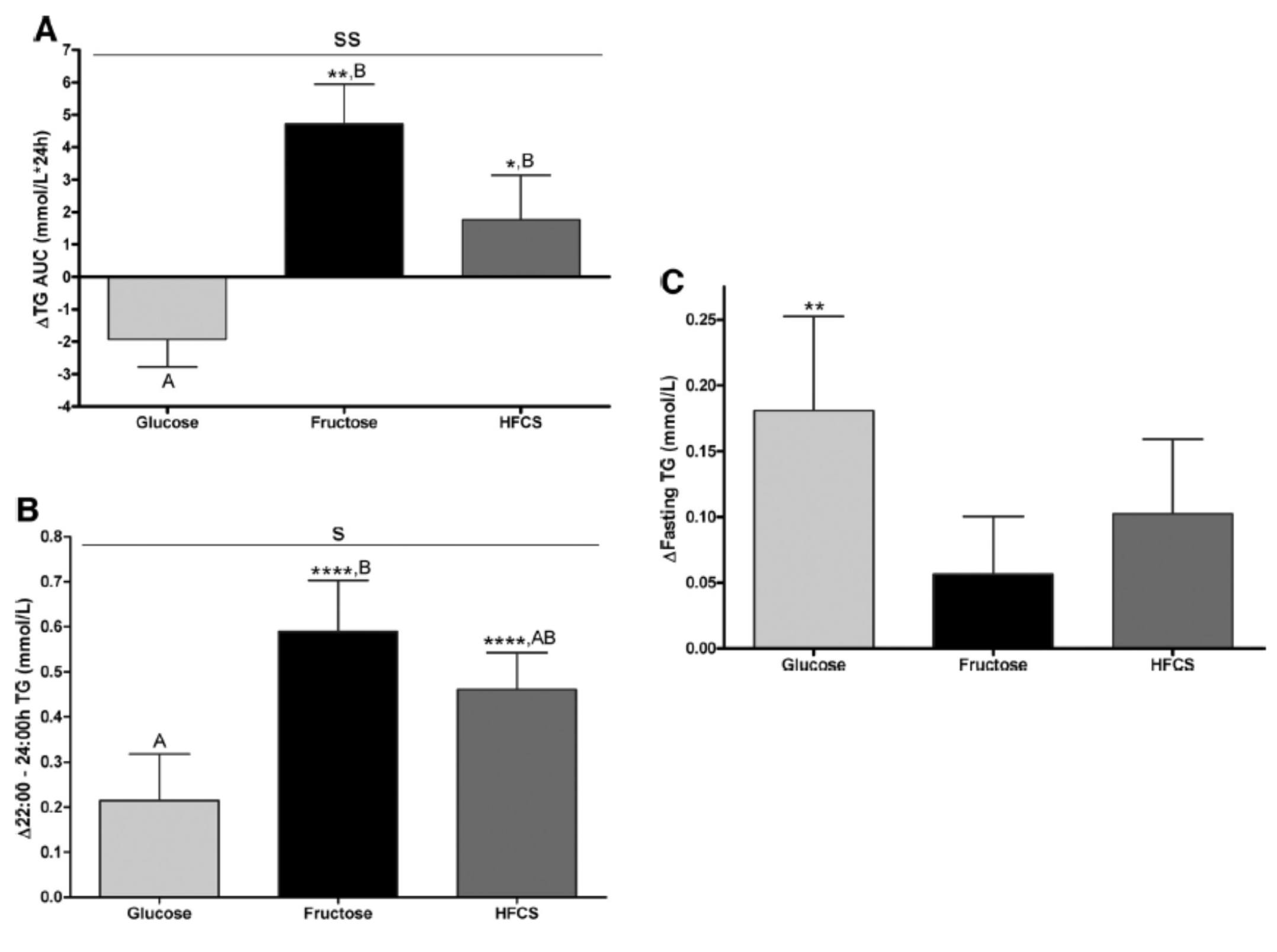
The differences were striking. The group that had all fructose and HFCS removed from their diet, despite still ingesting 55% of their total intake in the form of non-sugar carbohydrates, experienced a decline in total TG (Figure A, which represents the daily integral of plasma TG levels, or AUC). However, that same group experienced the greatest increase in fasting TG levels (Figure C). Post-prandial TG levels were elevated in all groups, but significantly higher in the fructose and HFCS groups (Figure B). The question this begs, of course, is which of these measurements is most predictive of risk?
Historically, fasting levels of TG are used as the basis of risk profiling (Figure C), and according to this metric glucose consumption appears even worse than fructose or HFCS. However, recent evidence suggests that post-prandial levels of TG (Figure B) are a more accurate way to assess atherosclerotic risk, as seen here, here, and here. One question I have is why did the AUC calculations in Figure A show a reduction in plasma TG level for the glucose group?
The figure below summarizes the differences in LDL-C, non-HDL-C, apoB, and apoB/apoA-I.
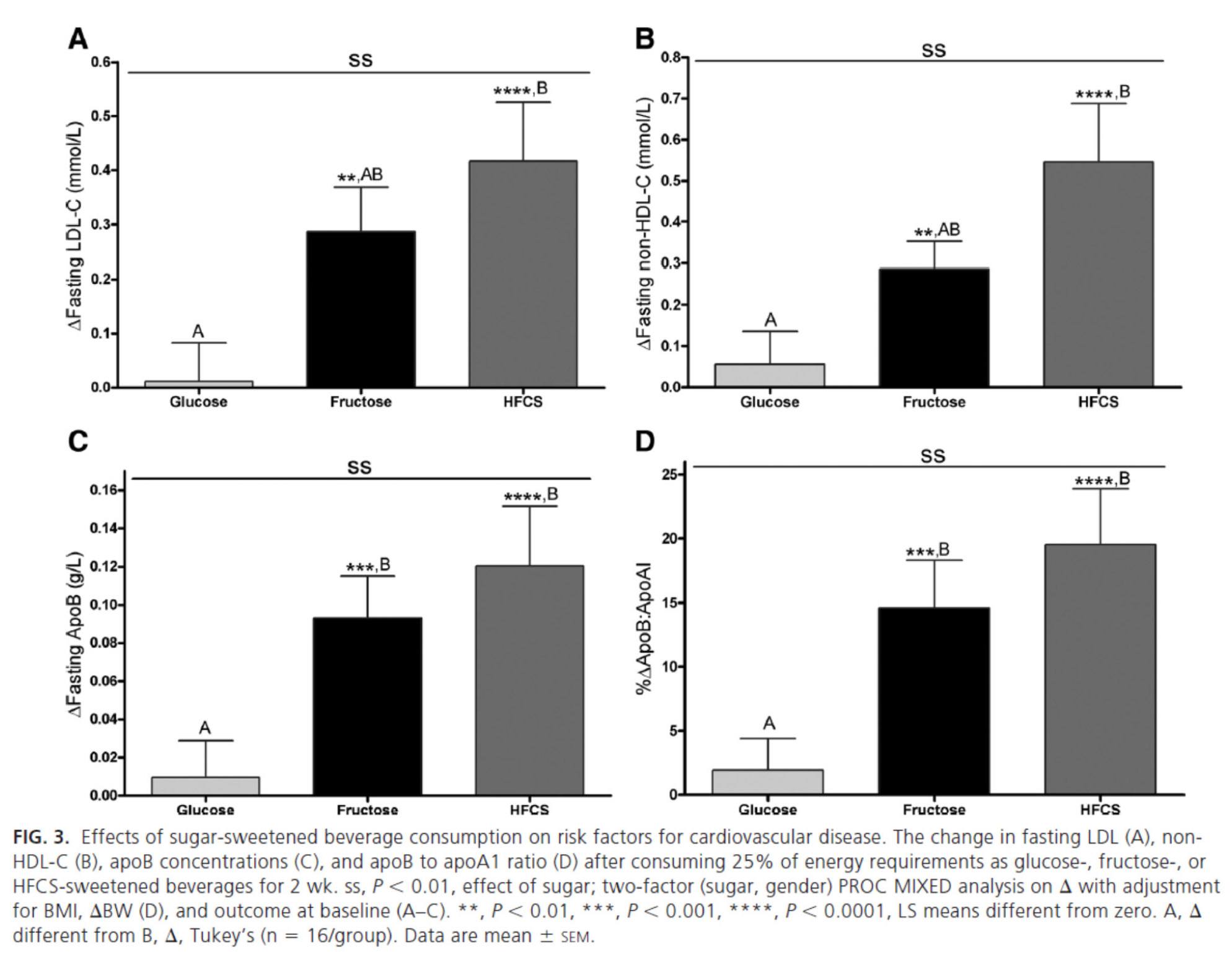
Again, the results were unmistakable with respect to the impact of fructose and HFCS on lipoproteins, and by extension, the relative lack of harm brought on by glucose in isolation. [Of course, removal of glucose and fructose/HFCS would have been a very interesting control group.]
One of the simultaneous strengths and weaknesses of this study was the heterogeneity of its subjects, who ranged in BMI from 18 to 35, in age from18 to 40, and in gender. While this provided at least one interesting example of age-related differences in carbohydrate metabolism (older subjects had a greater increase in triglycerides in response to glucose than younger subjects), it may have actually diluted the results. There were also significant differences between genders in the glucose group.
What was most interesting about this study was the clear difference between the 3 groups that was not solely a function of fructose load. In other words, the best outcome from a disease risk standpoint was in the glucose group, while the worst outcome was not in the all-fructose group, but in the 50/50 (technically 55/45) mixed group. This is a very powerful indication that while glucose and fructose alone can be deleterious in excess, their combination seems synergistically bad.
The role of saturated fat in cardiovascular disease
In the next week or two I’ll be posting an hour-long comprehensive lecture I gave at UCSD a few weeks ago on this exact topic. Rather than repeat any of it here, I’ll highlight one study that I did not include in that lecture. The study, Effect of a high saturated fat and no-starch diet on serum lipid subfractions in patients with documented atherosclerotic cardiovascular disease, published in 2003, treated 23 obese patients (average BMI 39) with known cardiovascular disease (status post coronary artery bypass surgery and/or stent placement) with a high-fat ketogenic diet. Because the study was free-living and relied on self-reporting, not all subjects had documented levels of elevated serum B-OHB. However, the subjects were instructed to avoid starch and consume 50% of their caloric intake via saturated fat, primarily in the form of red meat and cheese. There were no restrictions on fruits and vegetables, which may have accounted for the observation that not all subjects were ketotic during the 6-week intervention. In total, only 5 of the 23 patients achieved documented ketosis.
All of the subjects were on statins and entered the study at a goal LDL-C level target of 100 mg/dL, which may have been the only way the authors could get the IRB to approve such a study.
The table below shows the changes in lipoprotein fractions following the intervention (there was no control group):

This study was conducted during the height of the “outcry” over the Atkins diet. While most doctors reluctantly agreed that Dr. Atkins’ diet could reduce body fat, most believed it was still very dangerous. In the words of Dean Ornish, “Sure you can lose weight on a low-carb diet, but you can also lose weight on heroin and no one would recommend that!”
Fair point. In fact, the authors of this study acknowledged that they “strongly expected” this dietary intervention to increase risk for cardiovascular disease, which is why they only included subjects on statins with low LDL-C. However, as you can see from the table above, the authors were startled by the results. The subjects experienced a significant reduction in plasma triglycerides and VLDL triglycerides, without an increase in LDL-C or LDL-P. In fact, LDL size and HDL size increased and VLDL size decreased – all signs of improved insulin resistance. Furthermore, fasting glucose and insulin levels also decreased significantly. The mean HOMA-IR was reduced from 5.6 to 3.6 (normal is 1.0) and TG/HDL-C from 3.3 to 2.0 (normal is considered below 3, but “ideal” is probably below 1.0) in just 6 weeks. Taken together, these changes, combined with the dramatic change in VLDL size, suggest insulin resistance was dramatically improved while consuming a diet of 50% saturated fat!
As all of these patients were taking statins, we’re really robbed of seeing the impact of this diet on LDL-P, which did not change. Also, CRP levels rose (though not clinically or statistically significantly).
Putting it all together
It is very difficult to make the case that when carbohydrates in general, and sugars in particular, are removed or greatly reduced in the diet, insulin resistance is not improved, even in the presence of high amounts of saturated fats. When insulin resistance improves (i.e., as we become more insulin sensitive), we are less likely to have the signs and symptoms of metabolic syndrome. As we meet fewer criteria of metabolic syndrome, our risk of not only heart disease, but also stroke, cancer, diabetes, and Alzheimer’s disease goes down.
Furthermore, as this study on the Framingham cohort showed us, the more criteria you have along the spectrum of metabolic syndrome, the more difficult it becomes to predict your risk, due to a widening gap in discordant risk markers, as shown in this figure.
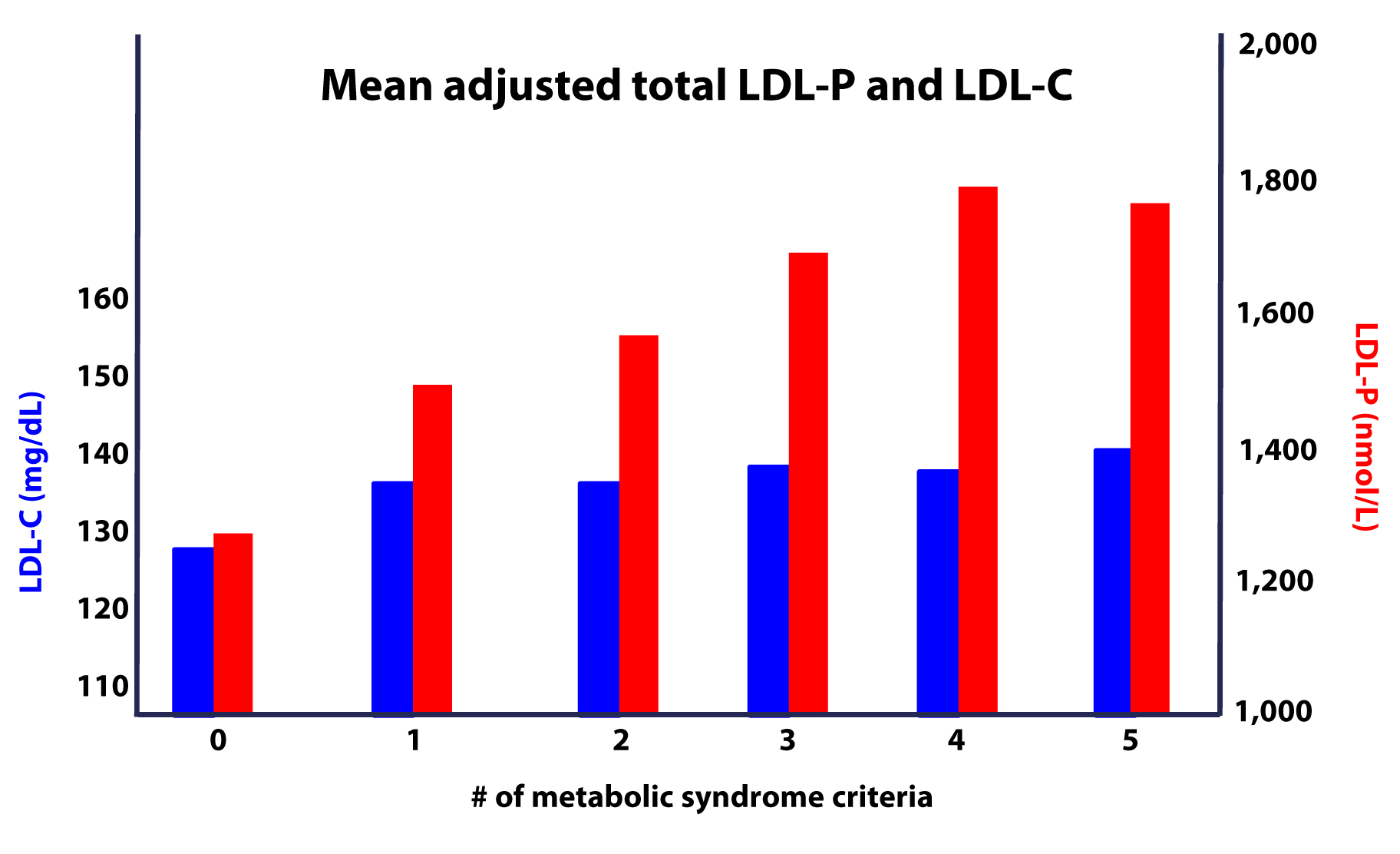
As I noted at the outset, the “dream” trial has not yet been done, though we (NuSI) plan to change that. Until then each of us has to make a decision several times every day about what we will and won’t put in our mouths. Much of this blog is dedicated to underscoring the impact of carbohydrate reduction on insulin resistance and metabolic syndrome.
The results of the trials to date, combined with a nuanced understanding of the lipoprotein physiology and their role on the atherosclerotic disease process, bring us to the following conclusions:
- The consumption of sugar (sucrose, high fructose corn syrup) increases plasma levels of triglycerides, VLDL and apoB, and reduces plasma levels of HDL-C and apoA-I.
- The removal of sugar reverses each of these.
- The consumption of fructose alone, though likely in dose-dependent fashion, has a similar, though perhaps less harmful, impact as that of fructose and glucose combined (i.e., sugar).
- The addition of fat, in the absence of sugar and starch, does not raise serum triglycerides or other biomarkers of cardiovascular disease.
- The higher the level of serum triglycerides, the greater the likelihood of discordance between LDL-C and LDL-P (and apoB).
- The greater the number (from 0 to 5) of inclusion criteria for metabolic syndrome, the greater the likelihood of discordance between LDL-C and LDL-P (and apoB).
I would like to address one additional topic in this series before wrapping it up – the role of pharmacologic intervention in the treatment and prevention of atherosclerotic disease, so please hold off on questions pertaining to this topic for now.


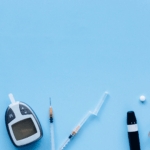
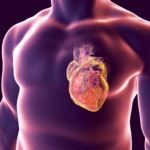
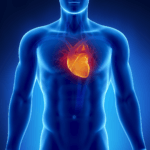

Peter, another excellent post. I don’t think anyone was on the edge of their seats with regard to the outcome, but it was good for the train to get to the station. I have been low carbing for about 6 months and although I know it is the best for my long term health, I really miss some of my favorite old foods. I read forums like yours to keep on the straight and narrow as they say.
Maybe Ornish is on to something – a diet trial of Heroin users vs. Low Carb – winner take all!!! As to you old ex girlfriend that story reminded me of an Agatha Christie quote – “The best husband a woman can have is an Archaeologist – the older she gets the more interested he is in her”.
I love the idea of the diet trial: Heroin (and NO food at all) vs. ultra-low fat vs. ultra-low carb…
All other things being equal (if such were possible), I understand that controlled and sanitary heroin increases life span. Who knows?
What we do know is that legal drugs kill more Americans than illegal drugs. And that prescription drugs are the 4th leading cause of death in the US.
Peter great post as usual. Is being keto adapted an either or situation or more along the lines of once you are keto adapted you can drift in and out of burning fat depending on your carb intake?
It really seems to be a pretty distinct metabolic state, primarily in terms of providing the brain with enough B-OHB to offset the reduction in circulating glucose levels.
The bottle of gin in that bag looks weird.
New to your blog Peter. Just marvelous work, thank you.
I wonder if you have seen this fellows work and also where Vitamin D might fit in the picture ?
Dr. Gerhard Spiteller ==>
https://www.ncbi.nlm.nih.gov/pubmed/16843819
https://www.ncbi.nlm.nih.gov/pubmed/20230283
https://www.ncbi.nlm.nih.gov/pubmed/11976183
https://www.ncbi.nlm.nih.gov/pubmed/16270286
Raymund, I’ll be doing a (mini) series or at least a post or two in Vitamin D in the future.
Peter, do you think a low-carbohydrate diet becomes more effective (i.e., exponential) at reducing risk-factors the longer someone adheres to the diet or is the reduction fairly linear over the entire duration? If it’s the former, then a long-term study might be even more revealing about the potency of a low-carb diet for reducing CVD risk-factors. As you mentioned in this article, there’s yet to be any long-term clinical studies on a low-carb diet, but based on your own practice and observations from your colleagues (such as Dr. Dayspring’s patients), what is your take on this?
My intuition says it probably depends on where one is starting form in terms of risk. Quicker plateaus for those starting with less risk, or those starting later in life. All speculation.
I’m listening to Lana Del Rey sing “Blue Jeans” as I compose this – Jesus – she’s something else – in a good way –
Anyway – back to reality – here’s my lipid results from last week –
TC – 165
LDL – 104
HDL – 51
TG – 54
VLDL – 11
NON – HDL – 114
Apo – B – 76 (Particle Count about 850)
Apo – A1 – 127
I was a little bit dissapointed my Apo – B wasn’t lower And my Apo – A1 wasn’t a little higher –
I don’t think anyone could complain with those numbers.
Aren’t there studies showing that higher cholesterol in older people is more protective than low cholesterol and that people, especially senior citizens, with very low cholesterol number tend to die at a higher rate for all causes, include suicide. (Too low cholesterol is bad for the brain. Certain violent criminals have been found to have very low cholesterol.)
It’s certainly true and well documented that people with very low cholesterol die sooner than those with “normal” cholesterol, though not of coronary heart disease. Combine this with the also-documented fact that folks with very high cholesterol (e.g., FH) actually have protection from other causes of death, such as infection. This body of literature suggests three things I subscribe to:
1. Cholesterol is vital for life! Very low levels probably lead to reduced immune function, among other things.
2. The lower the cholesterol (really, the lower the level of LDL particles) the less your cardiac risk.
3. It’s a balancing act — too much or too little is associated with a shorter life.
In men , the U shaped curve is true according to the Framingham study, but what about women where the curve is flat and if anything, the higher the cholesterol the better the survival rate?
Great post as always, thanks.
However, I do think you might have overlooked one critical aspect of diet. The conversion of fructose to triglycerides is generally very low (<10%), however, when fructose (and this goes for carbohydrates in general) is provided as calories in excess, that is when triglyceride levels really start ramping up. So while I agree that fructose, and other carbohydrates can shift 'cholesterol' to VLDL and small LDL, I do think it is important to emphasize that in hypocaloric conditions the effects really are not so disastrous (take for example the Kitavas of Papua New Guinea who have undetectable incidence of heart disease, yet eat a considerable amount of carbohydrates 70% of total intake).
I'm very interested in your take on this, and on your take on statins in the next post. Sincerely, Nils
The conversion has a lot to do with not just caloric load, but also glycogen storage capacity. At the end of a marathon, if someone has virtually no liver glycogen remaining, even a pretty large does of fructose will preferentially be converted to glycogen over TG/VLDL. However, modest doses of fructose in the presence of largely full glycogen reverse causes the reverse. So, yes the issues is load and glycogen capacity dependent. But remember — how many folks are running marathons AND limiting their fructose consumption to just the amount necessary to re-fill (hepatic, not muscle) glycogen stores?
Thanks for the answer, I do however believe you are overestimating fructose to TG conversion in humans. While in many animals (rats, hamsters etc) the conversion is very great. In humans the picture is definitely somewhat different (again, assuming hypo or iso caloric conditions).
https://physrev.physiology.org/content/90/1/23.long
Showed that about 50% of fructose is converted to glucose, 25% to lactate, some to liver glycogen stores and then some is oxidized on the spot and the remainder is converted to TG. This might also explain why sucrose and HFCS work synergistically, as fructose intake in addition to glucose might push the conversion more to TG.
Yeah, but the Kitavans:
1) Eat very little fructose
2) Their fat, while a small portion of calories are nearly all saturated and about zero Omega-6
3) They eat ONCE A DAY
Their “carbs” are almost entirely glucose-producing starches. It fits everything in this post.
Wow that 2003 study is very interesting Dr. Attia. With this post on carbohydrates, saturated fat and insulin resistance…I was wondering what your opinion was on the ADA diet which is low saturated fat (less than 7%) and high in whole grain carbohydrates with diabetics.
Additionally, your last post on HDL motivated me to look up Dr. Dayspring’s lecture on it and make another comic if you’re interested! https://thefatnurse.wordpress.com/2012/07/05/hdl-for-all-ages/
Next week I’ll be posting a talk I gave on saturated fat. By the end of that 55 minute talk you’ll know exactly where I stand on the ADA recommendation of <7% SFA! Promise!
I guess that Sniderman’s paper dovetails nicely with the Paleo theory. For the last 99,900 years, if your heart made it to 50 (assuming you made it to 15 or 20 first, that was the trick), it had done its job and the rest was gravy (I crack myself up sometimes…).
In order to maintain a heart that was not designed to overcome the “advantages” of modernity, we need to either apply technology (statins) or revert to a pre-modern diet.
I think that is a logical extrapolation.
Reminds me of the research by Geoffrey B. West on invariances between organisms.
https://www.darkcoding.net/research/gbwscl99.pdf
At a heart rate of 75bpm and the invariant of 1.5e9 beats per lifetime that puts the expected human lifespan at 38 years. Apparently we are doing sometime right that we live about double that amount nowadays.
Peter Attia..You have written very good post.I just came a cross here and found so interesting discussion here.Love your blog and especially your for effort .You are doing excellent work.Have a great regards for your awesome and adorable work
Beautiful write-up, Peter. Again a very pertinent choice of proof and fool-proof reasoning as far as I can see. 🙂 Thank you for the effort.
Your question: “One question I have is why did the AUC calculations in Figure A show a reduction in plasma TG level for the glucose group?”
My answer: because the liver mainly needs to convert non-glucose to TG; I bet that the extra dietary glucose went straight into blood sugar, bypassing TG transport.
The take-away points, for me, are:
From the first study:
– Fructose and glucose/fructose combination make our metabolic system spike intensely between post-prandial and fasting levels. This, in itself, may be a very important key in the development of the disease – aggressive serum peaks in TG, BG, Insulin, and LDL may very well cause more damage than an elevated continuous base / fasting level. High glicated hemoglobin along low fasting BG in certain subjects I know comes to mind. The damage may actually be coming primarily from the prandial spikes, and not from the area under the curve. Sorry, I don’t mean to contradict you, it just comes out naturally. 😉
– Glucose is not that bad, in fact our metabolic system seems to regulate it very well along time, preventing extreme highs and lows. I like it that fasting TG is more levelled when feeding on glucose, it shows that the system behaves well in this situation. But you’ve made no comment about blood glucose, and I dare say that the subjects in group 1, although they have lower TG they will have higher BG (including post-prandial spikes) and this will cause higher oxidative stress and AGE production. So I’m not that sure they are so better off. Total reduction of sugars (glucose sources included) is probably better than just fructose reduction.
Regarding the second study.
– Partial confirmation of my personal anecdote that LDL does not increase visibly with saturated fat consumption (I’m not on any meds). However, my HDL went up and CRP and Homocistein went down, whereas theirs didn’t. Ignoring for a moment my personal difference, is it possible that their free consumption of sugary fruit interacted with the high fat and caused a little extra inflammation? Again, the best course of action seems to be radical elimination of all sugar sources.
– Improved IR with sat fat. Vindication of the “a calorie is not a calorie” mantra. 🙂
Keep’em coming, the party is just starting! 😀
To further Pierre’s great question. Assuming the standard state of ketosis is 80-65 mg/dl, if someone is fluctuating between 75 and 100 mg/dl on the ketone monitor within any given day, could it be problematic switching between ketones and glucose fuel? Let’s say someone tests 3 times a day to test what amounts of foods are causing them to spike glucose.
Peter, thank you for the response.
Do we know whether a person needs to stay within a range of .5 to 3.mmol in order to avoid going through induction again? My intepretation of induction is training the body to use ketones as an energy source. Or is it a period of time a person remains less .01 mmol that breaks his bodies ability to burn ketones and causes there to be a need to go back to induction?
Thank you for any light you can shed.
Not sure what you mean by induction. Do you mean transition? I know the term “induction” is used in the Atkins diet to refer to a period of initial ketosis before transitioning to low-carb-non-ketosis.
When you’re out due to “dietary violation” it can take between 1 and 5 days to get back in.
Sorry Peter, I wasn’t clear about induction. In Atkins there is a period of time called induction where you must eat less than 20g of carbs in order to train your body to use ketones. Thank you for interpreting what I said and still answering my question!
Good comment of cardiologist Dr. William Davis on diet and treatment Apo E4;
https://www.wheatbellyblog.com/2011/07/who-is-dr-william-davis/comment-page-6/#comment-12342
First, no need to panic. Apo E4, even in homozygotes (2 “doses” of the gene), is highly variable. It is not an all or none situation.
My approach is a bit different than what is generally preached. I say prioritize all the metabolic parameters and clean them up, one by one. I advocate undergoing lipoprotein testing, e.g. NMR lipoprotein testing, as well as other metabolic markers, such as HbA1c, glucose, insulin, vitamin D.
You are likely to find that you have a lot of small as well as large LDL particles. The small come from carbohydrates and excess weight. The large come from fat consumption. Prioritize: Tackle the small LDL particles first by cutting carbohydrates, then ratchet fat intake back to reduce the excess of large LDL particles.
Also, my forum on the https://www.trackyourplaque.com website provides discussions of such more complicated issues, if you are interested in pursuing.
By “all signs of improved insulin resistance”, do you mean, “all signs of reduced insulin resistance”?
Yes, by improving IR, I mean reducing it or become more IS.
are you/we/anyone at the point to say its not safe to eat even lots of complex carbs like fruit and potatoes every day? I’d really like to tell my Fruitarian friend that its NOT healthly to eat 5lbs of fruit every day.
Look at how much fructose they are eating. This makes a very powerful case for even a fraction of that amount being troublesome.
Mark,
I’m at the point of saying that Steve Jobs committed premeditated suicide by ingesting nothing other than fruit and carrots for 32 years. It is pretty clear to me that such a behaviour would most probably result in metabolic organ failure sooner or later. His pancreas and his liver just gave out. I think that the thing that made him last 3 decades on this diet instead of just 2 is the fact that he insisted a lot in “purging” himself with meditation and fasting. While meditation is more or less proven to reduce stress factors, fasting is also proven to recycle cellular material through autophagy. I bet that if he didn’t do those things, he would have died about a decade earlier. Frutarianism just isn’t biologically sustainable for a human being in the long term, IMHO.
I have to say that the whole series has been brilliant and moreover educational to all who have taken the time to read it. Regarding dietary recommendations, it seems to me that if your LDL-P and HDL-P(to lesser extent) is at goal for your age and risk factors( do you have CAD,family history,etc) then the amount of carbs in the diet may not matter. Do you agree? If not why not, since the issue of artery damage is related to penetration of the wall by the particles, so the lower the particle level the better.
In my own case, I produce abnormally high particles whether i low carb or high carb. Only with meds(Crestor and Zetia) can I get LDL-P to goal(despite having a low TRG-75 on high carb and low LDL-C-73 without meds). What i do see if go zero starch and sugar on meds is that I virtually eliminate( <90) small LDL-P with some size increase, but no difference in total amount of LDL-P. So if size does not matter, it would appear to me that I can eat some level of carbs( berries, potatoes and rice only), based on this series, but Dr Krauss and Davis seem to think otherwise: they think small LDL is worse unlike Dr.Dayspring. Would be nice to have a debate among the titans. At nearly 62, I want to be as precise as possible. Thanks again for your great work!
Don’t forget, of course, mitigating disease risk is but one (albeit) important outcome of improving your nutrition. Don’t forget about body composition, athletic performance, energy levels, mental acuity.
One other comment: The effect of sat fat no starch diet study you reference does not do one important thing: it does not address whether CAD progression slowed or stopped in these patients. That is more important than any bio-marker. To really know one would need to do calcium score on these people or better yet IVUS which would show the health of the arteries and any narrowing of the lumen.
It did not address that, but other studies have showed us that non-pharmacologic interventions can *reverse* atherosclerosis. Unfortunately, the interventions were too numerous to identify which ones. I wrote about this study in Lancet in my Weight Watchers post.
“In the words of Dean Ornish, ‘Sure you can lose weight on a low-carb diet, but you can also lose weight on heroin and no one would recommend that!’” “Fair point.”
Not even remotely a fair point. This is just a logical fallacy called “Appeal to fear.” We are afraid of heroin, so we should be afraid of low-carb even though there is no relationship between heroin consumption and low-carb diets.
Point taken…I try to bend over sometimes to give my antagonists the benefit of the doubt. Thanks for keeping me honest.
Edward, I have eaten low carb on and off for a few years. In the early days I felt that it was a great tool to lose weight but that I might be doing long term harm to my health. After doing a lot of reading (this blog included) I no longer think that is the case. It’s 180 degrees from that, the only way to improve my health long term is to eat low carb. Which to me is a pretty amazing set of circumstances.
In 1995 I had a liver biopsy and they told me I had Steotosis of the liver (fatty liver). The only thing they told me to do was to not drink alcohol. I didn’t know then I could cure my issue by eating low carb. Since then this Internet thing has mushroomed and it’s a lot easier to find information. Unfortunately, a lot of it is BS. For any position on health you want to hold (almost) you can find someone somewhere who will support that view. It then comes down to who and what you want to believe. If it is T. Colin Campbell then you go Vegan and see how that does for you. In my case, I could never go without meat so that’s a non starter.
As far as the Heroin diet, I would say Keith Richards would be the poster boy for that one. He has a good BMI, but that’s probably about it. I have a secret suspicion that he’s been dead for some time but that nobody bothered to tell him.
This would be a good place to be able to hit “Like”. There is so much hype around this topic, as if my diet has an impact on the lives of everyone else. It has the flavour of religious war. One of the reasons I am ploughing through the detail in these posts and responses is the general ‘even keel’ around here.
“There were also significant differences between genders in the glucose group.”
aw, c’mon, Doc! 🙂 you can’t drop a bomb like that and then not explain what it was (unless it’s in those little graphs and i missed it…).
Although there were no significant sugar-gender interactions for any of the primary or secondary outcomes, men exhibited larger increases of fasting TG, non-HDL-C, apoB, and sdLDL-C concentrations and postprandial LDL, non-HDL-C, and sdLDL-C concentrations in response to sugar consumption than women.
Hi Tess:
“There were also significant differences between genders in the glucose group.”
What that means is that estrogen protects a woman’s heart & arteries until menopause. Then the free ride’s over.
That’s a very interesting subject and, I think, underexplored in the “paleo / LC blogosphere”.
Several friends of mine started following my “paleo / primal” dietary advice (I point them to Gnolls.org and Mark’s Daily Apple for everyday advice), and for the most part with resounding success.
The only exceptions: 2 women, one in her late 30s, another in her early 40s. They say that eating fat makes them fat, and cutting carbs did not yield visible weight loss. They do, however, report increased energy levels on low carb.
Since all the men I know who have tried this get immediate positive results, I’m inclined to think that female metabolism is fundamentally different from male at some level, and should be looked into more carefully.
Do you know of any low-carb blogs maintained by women?
Vasco,
Here is a blog “Paleo for Women: Evolutionary Health, Revolutionary Womanhood”
https://www.paleoforwomen.com/blog/